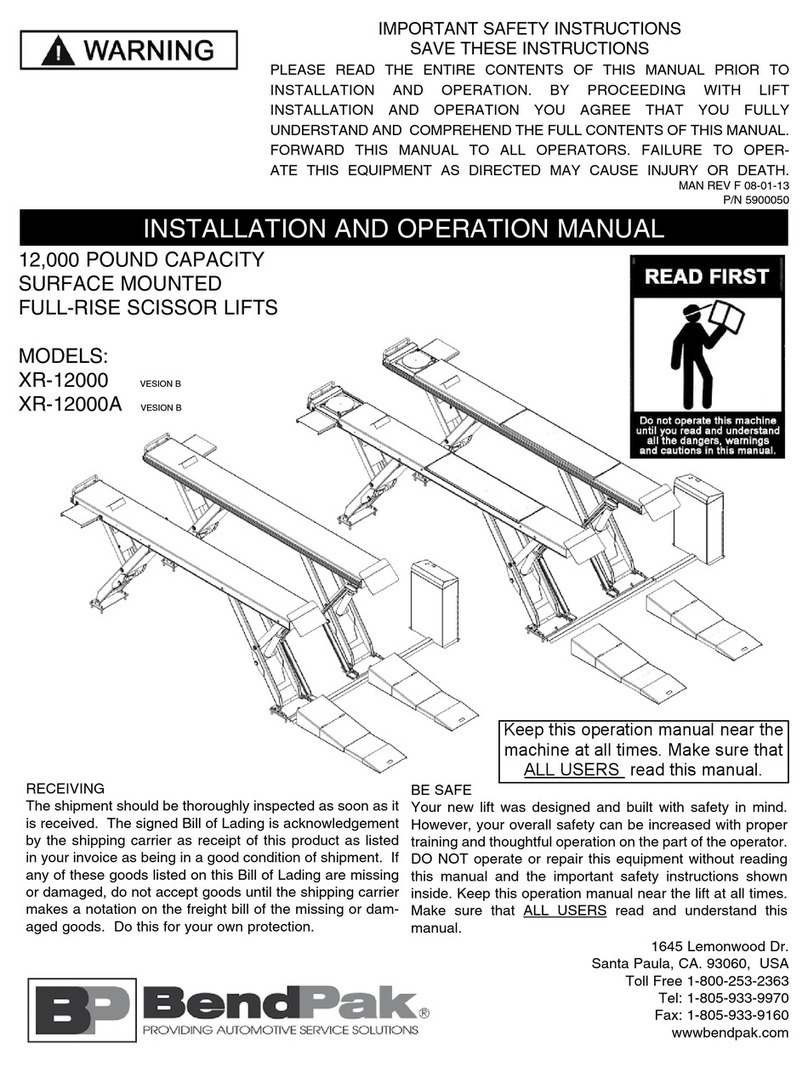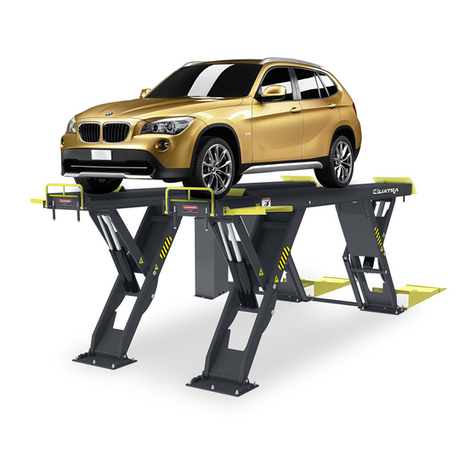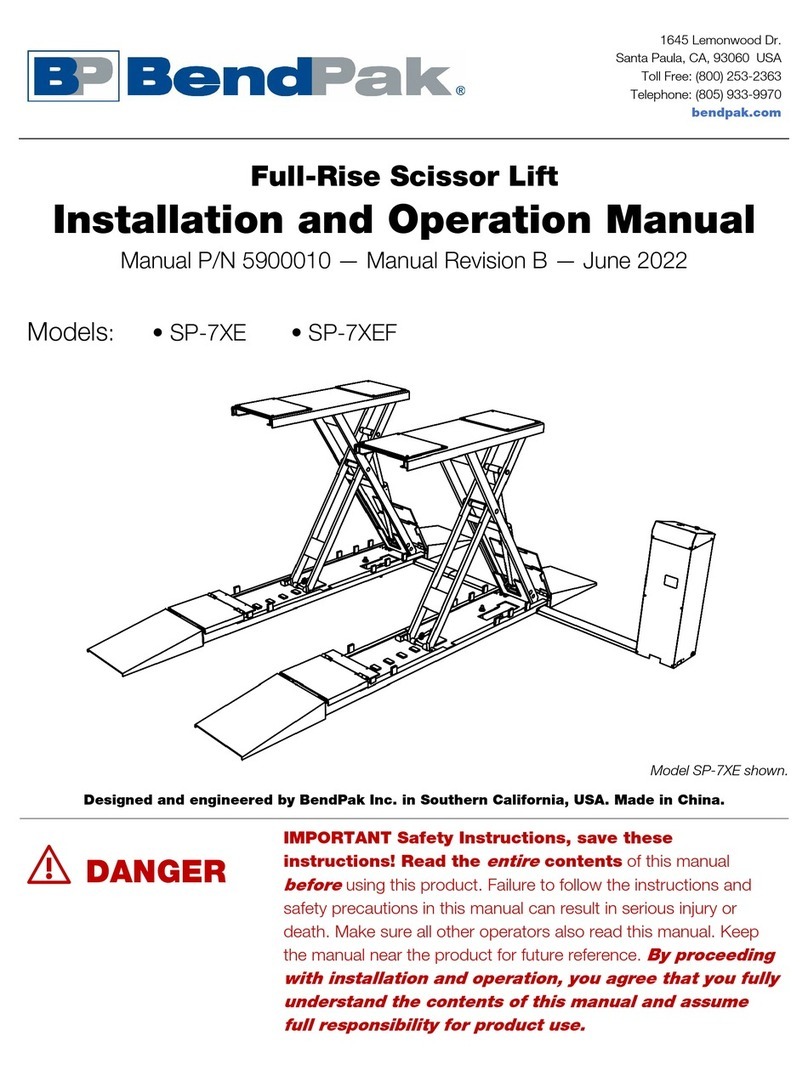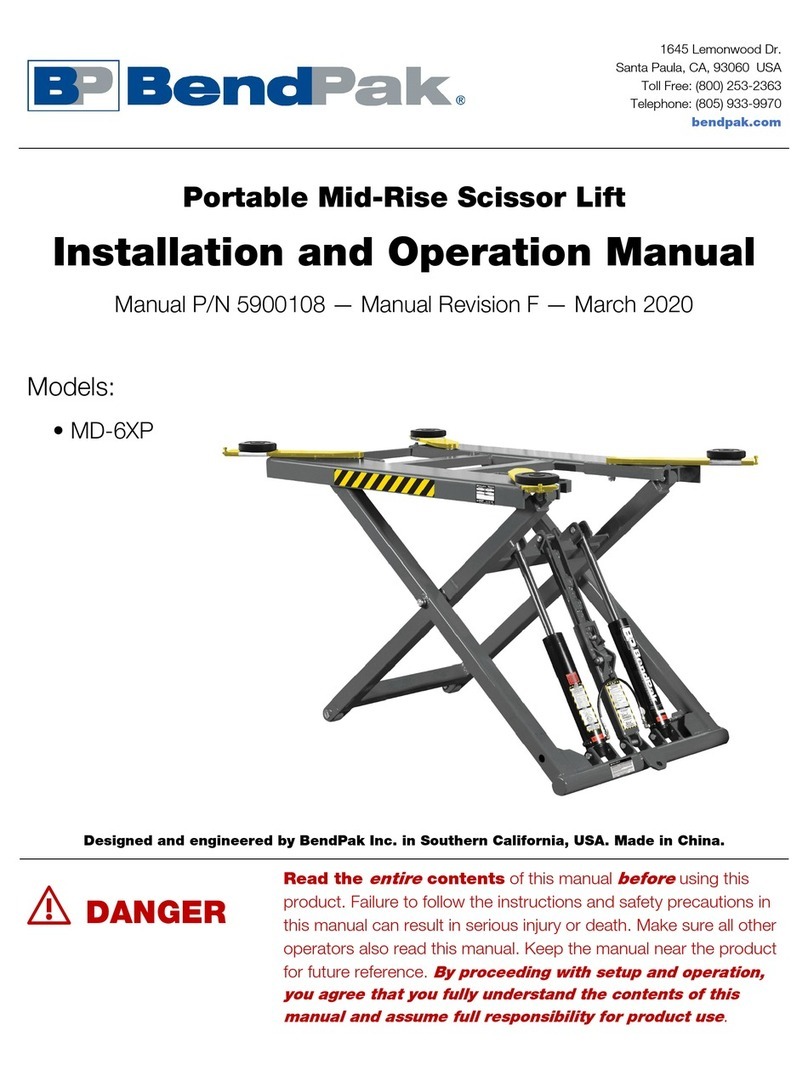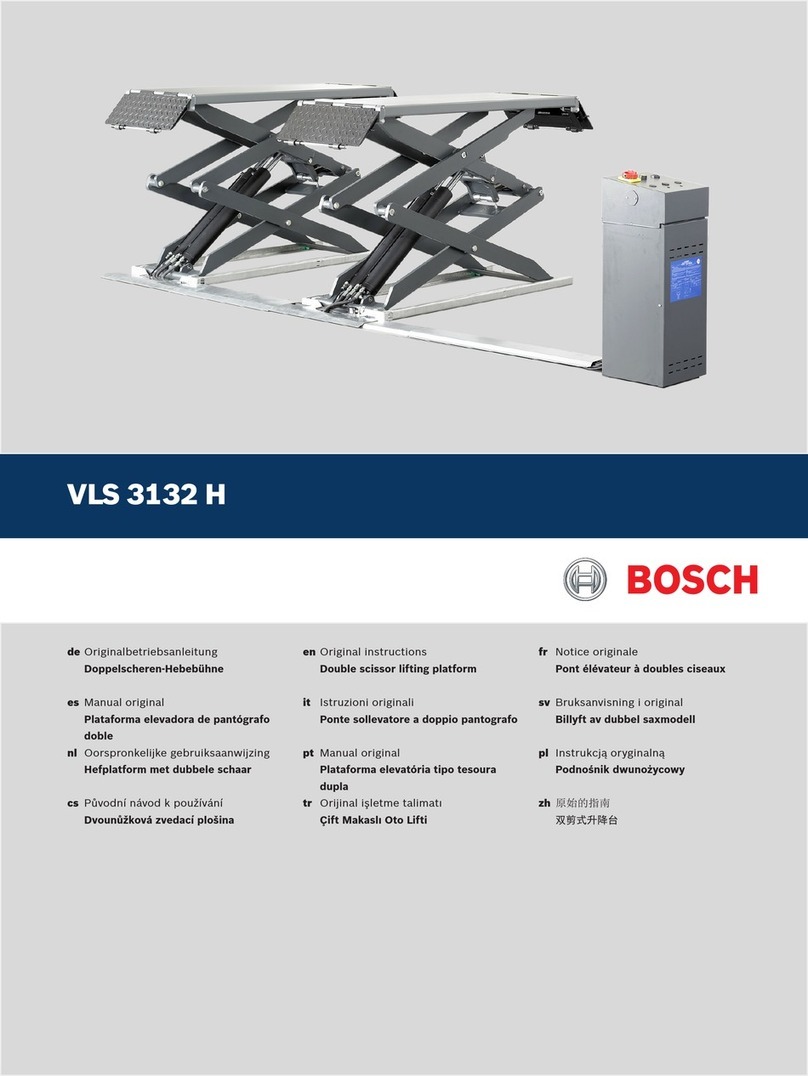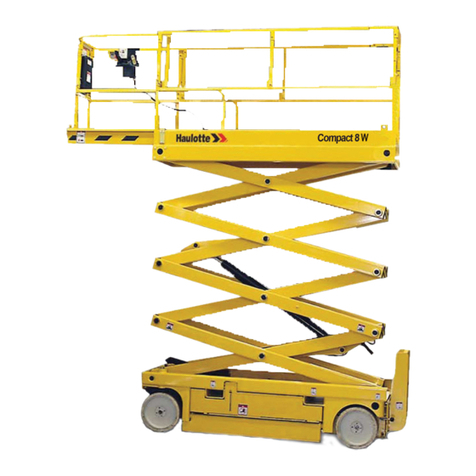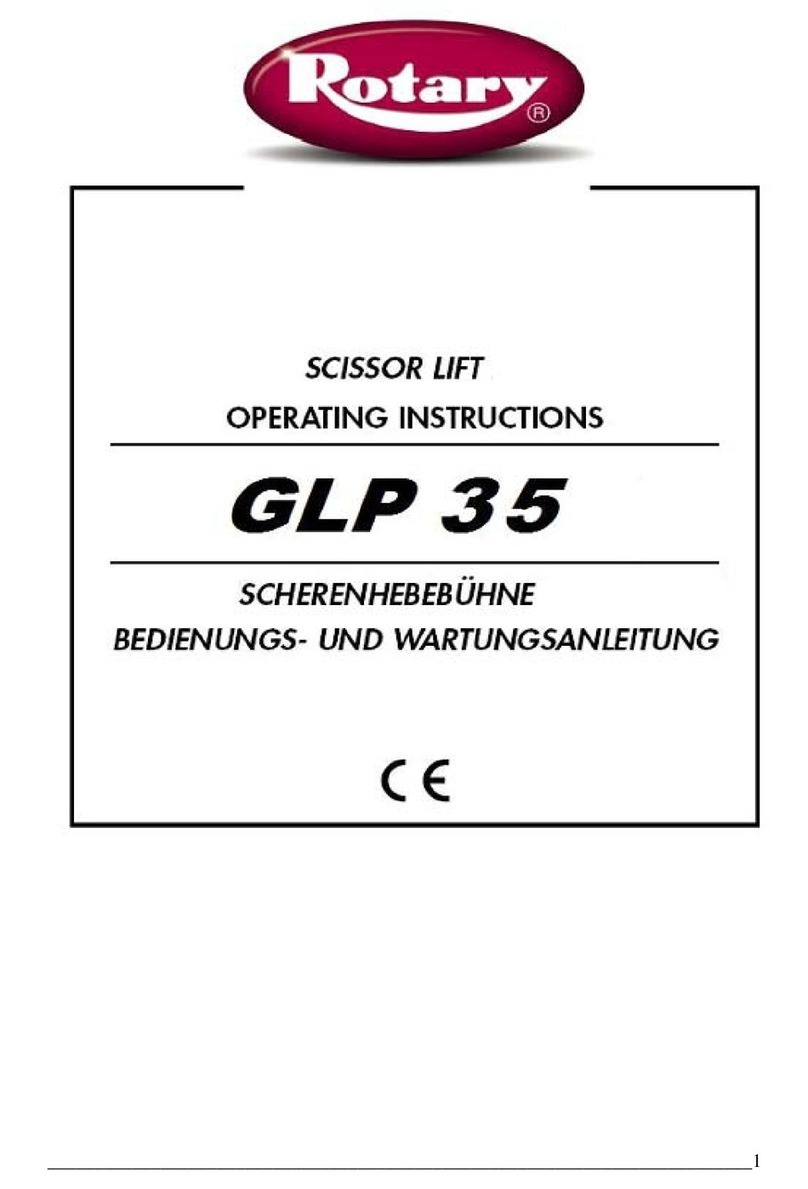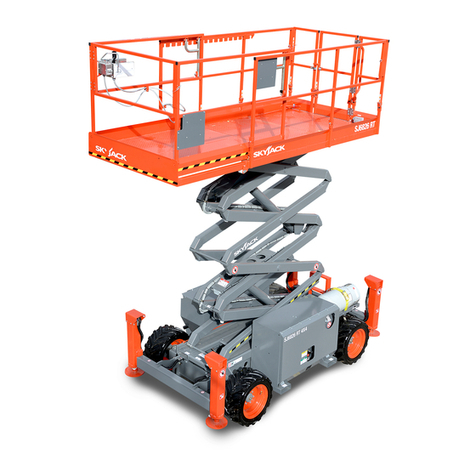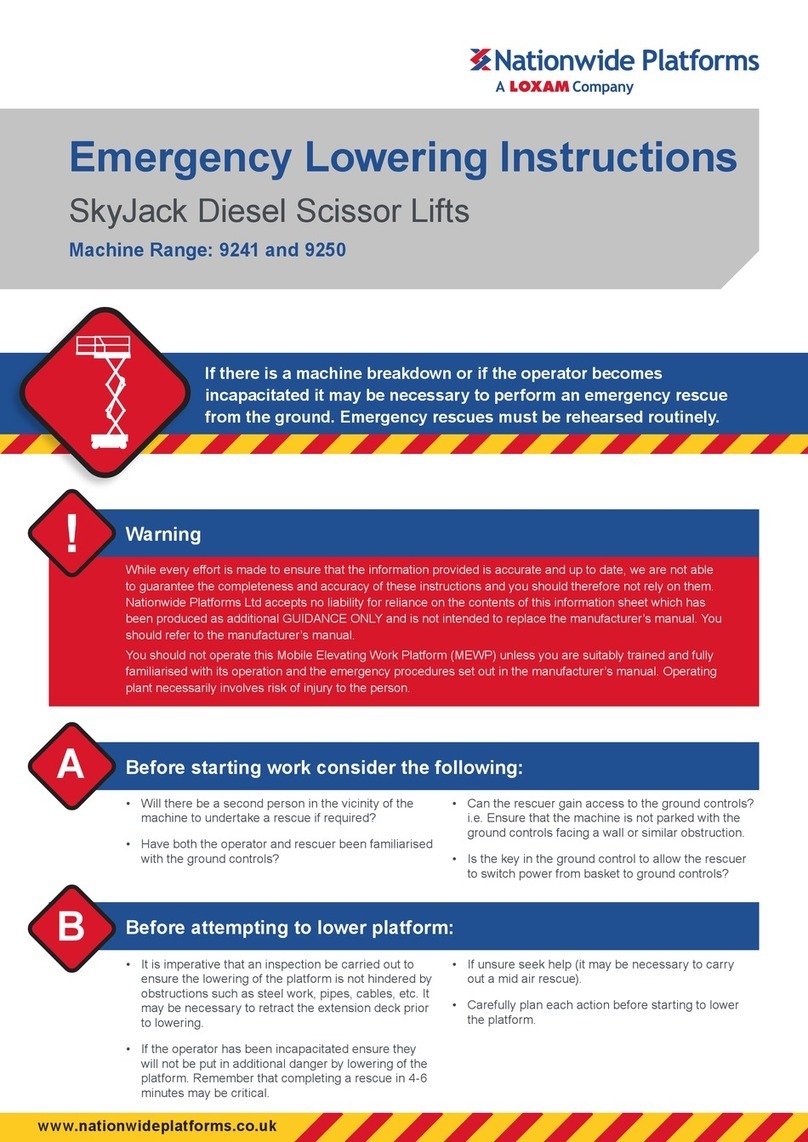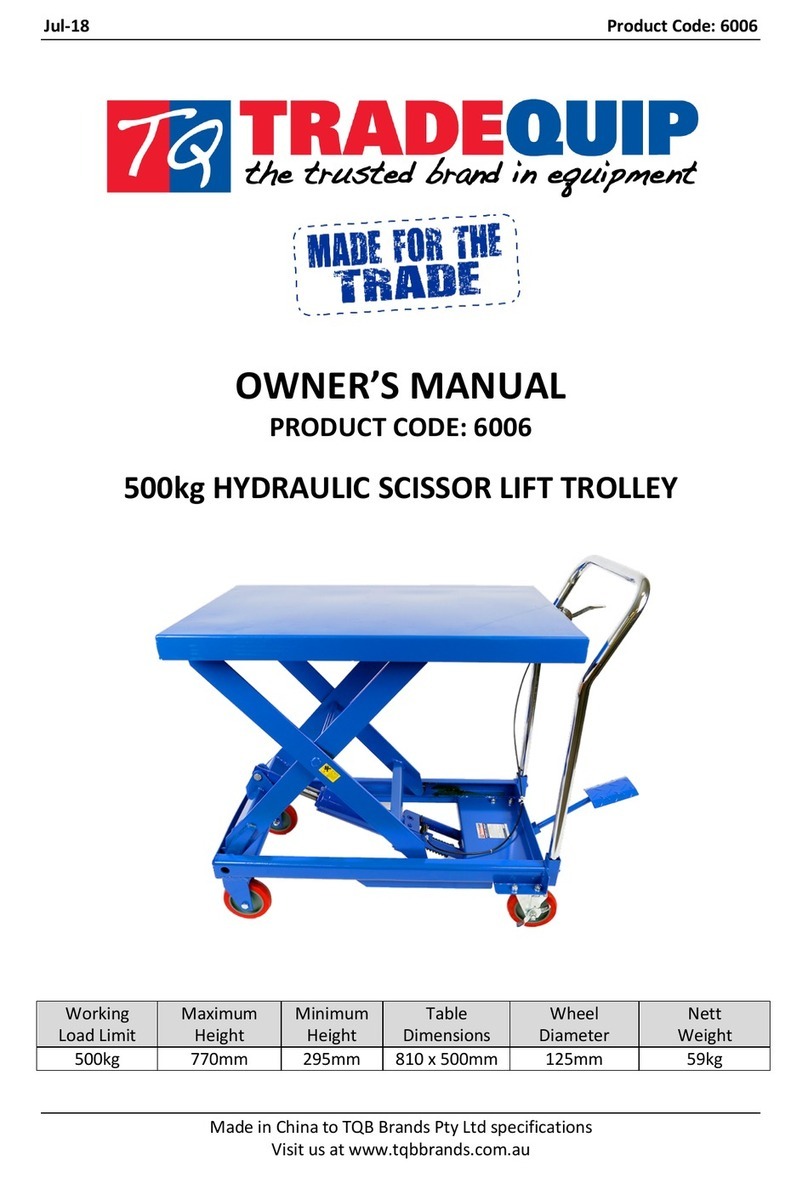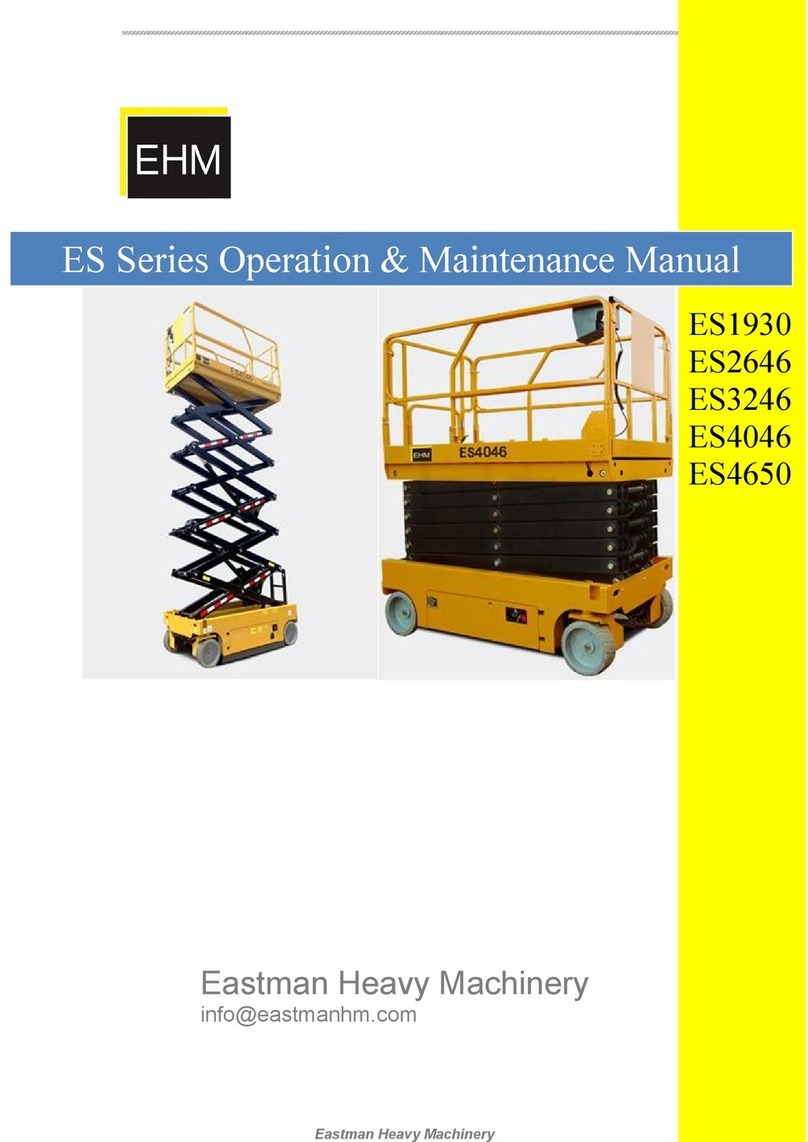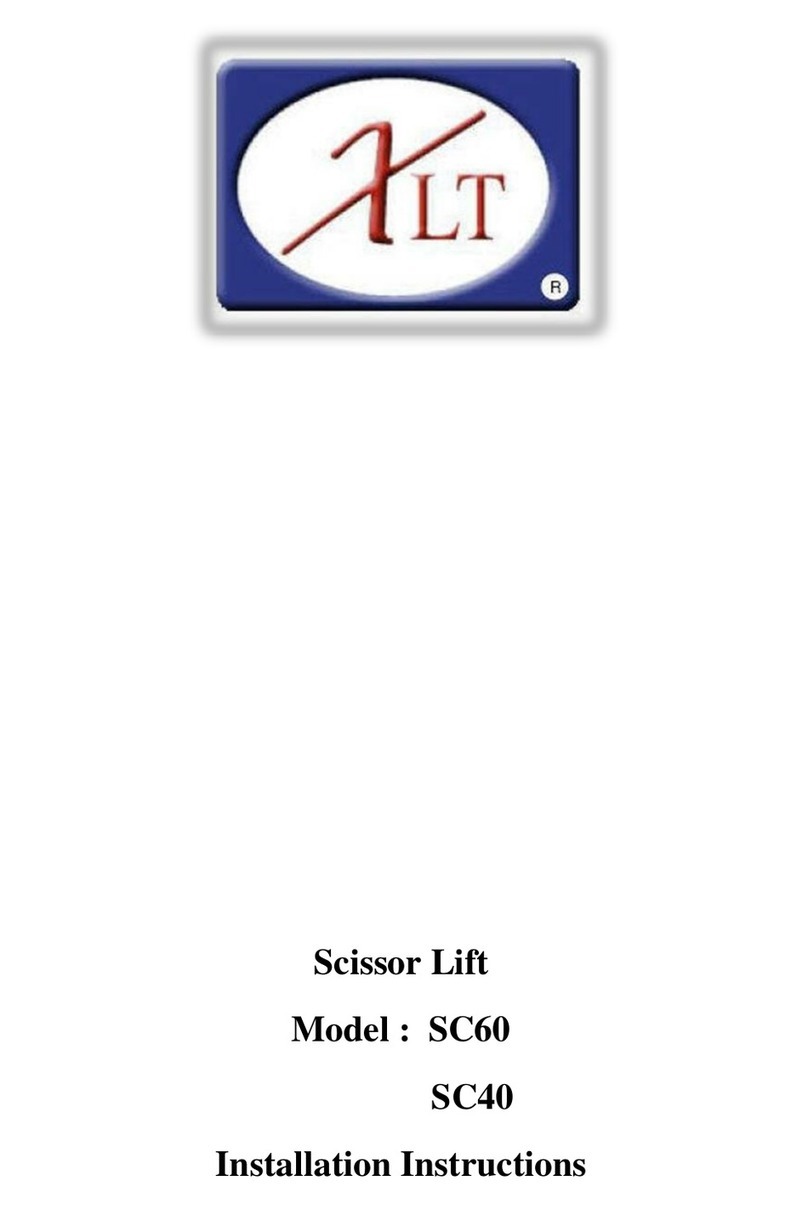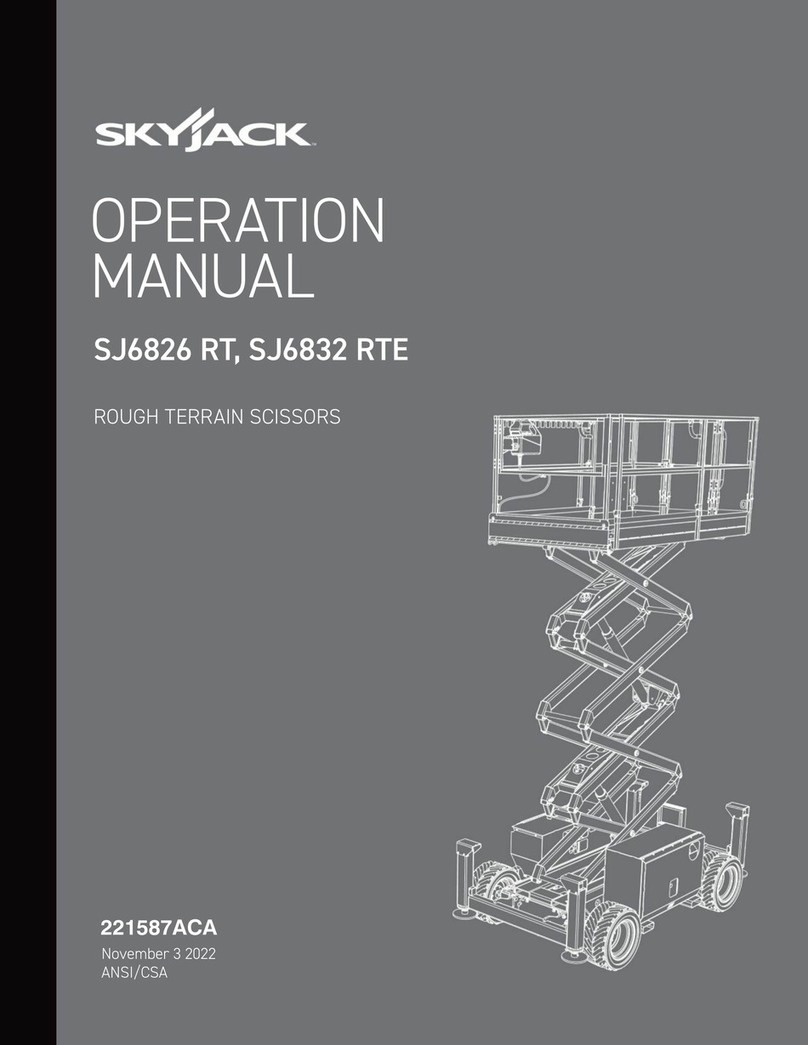Bend-Pak MDS-6EXT User manual

6,000 LB. / 2,722 KG. CAPACITY
MID-RISE SCISSOR CAR LIFT
Models:
• MDS-6EXT
• MDS-6EXTF
• MDS-6LP
• MDS-6LPF
1645 Lemonwood Dr.
Santa Paula, CA. 93060, USA
Toll Free 1-800-253-2363
Tel: 1-805-933-9970
Fax: 1-805-933-9160
www.bendpak.com
IMPORTANT SAFETY INSTRUCTIONS
SAVE THESE INSTRUCTIONS
PLEASE READ THE ENTIRE CONTENTS OF THIS MANUAL PRIOR TO INSTAL-
LATION AND OPERATION. BY PROCEEDING WITH LIFT INSTALLATION
AND OPERATION YOU AGREE THAT YOU FULLY UNDERSTAND AND
COMPREHEND THE FULL CONTENTS OF THIS MANUAL. FORWARD THIS
MANUAL TO ALL OPERATORS. FAILURE TO OPERATE THIS EQUIPMENT AS
DIRECTED MAY CAUSE INJURY OR DEATH.
Rev. A 02/21/2017
P/N 5900030
RECEIVING
The shipment should be thoroughly inspected as soon as it
is received. The signed Bill of Lading is acknowledgment
by the shipping carrier as receipt of this product as listed
in your invoice as being in a good condition of shipment. If
any of these goods listed on this Bill of Lading are missing
or damaged, do not accept goods until the shipping carrier
makes a notation on the freight bill of the missing or dam-
aged goods. Do this for your own protection.
BE SAFE
Your new lift was designed and built with safety in mind.
However, your overall safety can be increased with proper
training and thoughtful operation on the part of the operator.
DO NOT operate or repair this equipment without reading
this manual and the important safety instructions shown
inside. Keep this operation manual near the lift at all times.
Make sure that ALL USERS read and understand this
manual.
INSTALLATION AND OPERATION MANUAL

2
6,000 Pound Capacity
Mid-Rise Scissor Lift
This instruction manual has been prepared especially for you. Your new lift is the product of over 40
years of continuous research, testing, and development; it is the most technically advanced lift on
the market today.
READ THIS ENTIRE MANUAL BEFORE INSTALLATION & OPERATION BEGINS!
Record here the lift and power unit information
that is located on the serial number data plates
on the lift and on the power unit.
Power Unit Model # _____________
Power Unit Date Of Mfg. _____________
Power Unit Serial # _____________
Max Operating Pressure __2,650 PSI
This information is required when
calling for part or warranty issues.
Product Warranty
Our comprehensive product warranty means more than a commitment to you; it’s also a commitment to the value of
your new MDS-6EXT/MDS-6EXTF/MDS-6LP/MDS-6LPF BendPak lift. For full warranty details and to register your new
lift, contact your nearest BendPak dealer or visit: www.bendpak.com/support/warranty.
What is not covered under this warranty:
• Any failure that results from purchaser abuse, neglect, or failure to operate, maintain or service product in
• accordance with instructions provided in the manual(s), supplied.
• Any damage caused by overloading lift beyond rated capacity.
• Items or service normally required to maintain the product; for example, lubricants, oil, and so on.
• Items considered general-wear parts such as rubber pads, lifting cables, and so on unless wear or failure is a direct
result of manufacturer defect due to material and/or workmanship.
• Any component damaged in shipment or any failure caused by installing or operating the lift under conditions not in
accordance with installation and operation guidelines or damaged by contact with tools or surroundings.
• Motor or pump failure caused by rain, excessive humidity, corrosive environments, or other contaminants.
• Rusted components due to improper maintenance or corrosive environments.
• Cosmetic defects that do not interfere with product functionality.
• Damage due to incorrect voltage or improper wiring.
• Any incidental, indirect, or consequential loss, damage, or expense that may result from any defect, failure or
malfunction of the BendPak, Inc. product.
• All electrical components (excluding power unit) are guaranteed for one year against defects in workmanship and/or
materials when the lift is installed and used according to specifications.
NOTE:
Every effort has been taken to ensure complete and accurate instructions have been included in this manual, however, possible
product updates, revisions and or changes may have occurred since this printing. BendPak Ranger reserves the right to change
specications without incurring any obligation for equipment previously or subsequently sold. Not responsible for typographical errors.
Santa Paula, CA USA
www.bendpak.com
MODEL NUMBER
LIFT CAPACITY
SERIAL NUMBER
DESCRIPTION
VOLTAGE
DANGER!
Disconnect Power
Before Servicing
WARRANTY VOID IF DATA PLATE IS REMOVED
PN 5905951
110-240VAC, 50-60 Hz, 1 Ph 380-415VAC, 50-60 Hz, 3 Ph
208-240VAC, 50-60 Hz, 1 Ph 208-440VAC, 50-60 Hz, 3 Ph
DATE OF MFG.

3
IMPORTANT NOTICE
Do not attempt to install this lift unless you have been
trained on basic automotive lift installation procedures.
Never attempt to lift components without proper
lifting tools such as forklift or cranes. Stay clear of any
moving parts that can fall and cause injury. These
instructions must be followed to ensure proper
installation and operation of your lift. Failure to comply
with these instructions can result in serious bodily harm
and void product warranty. Manufacturer assumes no
liability for loss or damage of any kind, expressed or
implied resulting from improper installation or use of this
product.
PLEASE READ ENTIRE MANUAL
PRIOR TO INSTALLATION.
DEFINITIONS OF
HAZARD LEVELS
Identify the hazard levels used in this manual with the
following denitions and signal words:
Watch for this symbol. It means: Immediate hazards
that will result in severe personal injury or death.
Watch for this symbol. It means: Hazards or unsafe
practices that could result in severe personal
injury or death.
Watch for this symbol. It means: Hazards or unsafe
practices that may result in minor personal injury,
product, or property damage.
OWNER RESPONSIBILITY
To maintain the lift and user safety, the responsibility of
the owner is to read and follow these instructions:
t Follow all installation and operation instructions.
t Make sure installation conforms to all applicable local,
state, and federal codes, rules, and regulations;
such as state and federal OSHA regulations and
electrical codes.
t Carefully check the lift for correct initial function.
t Read and follow the safety instructions. Keep them
readily available for machine operators.
t Make certain operators are properly trained, know
how to safely and correctly operate the unit, and are
properly supervised.
t Allow unit operation only with all parts in place and
operating safely.
t Carefully inspect the unit on a regular basis and
perform all maintenance as required.
t Service and maintain the unit only with authorized or
approved replacement parts.
t Keep all instructions permanently with the unit and
all decals on the unit clean and visible.
BEFORE YOU BEGIN
Receiving. The shipment should be thoroughly inspected
as soon as it is received. The signed bill of lading is
acknowledgment by the carrier of receipt in good condition
of shipment covered by your invoice. If any of the goods
called for on this bill of lading are shorted or damaged, do
not accept them until the carrier makes a notation on the
freight bill of the shorted or damaged goods. Do this for
your own protection.
Notify the carrier at once if any hidden loss or damage
is discovered after receipt and request the carrier to make
an inspection. If the carrier will not do so, prepare a signed
statement to the effect that you have notied the carrier (on
a specic date) and that the carrier has failed to comply with
your request.
It is difficult to collect for loss or damage after you have
given the carrier a clear receipt. File your claim with the
carrier promptly. Support your claim with copies of the bill of
lading, freight bill, invoice, and photographs, if available. Our
willingness to assist in helping you process your claim does
not make BendPak responsible for collection of claims or
replacement of lost or damaged materials.

TABLE OF CONTENTS
Warranty / Serial Number . . . . . . . . . . . . . . . . . . . . . . . . . . . . . . . . . . . . . . . . . . . . . . . . . . . . . . . 2
Definitions of Hazard Levels . . . . . . . . . . . . . . . . . . . . . . . . . . . . . . . . . . . . . . . . . . . . . . . . . . . . . . . . . . . . 3
Owner’s Responsibility . . . . . . . . . . . . . . . . . . . . . . . . . . . . . . . . . . . . . . . . . . . . . . . . . . . . . . . . . . . . . . . . 3
Before You Begin. . . . . . . . . . . . . . . . . . . . . . . . . . . . . . . . . . . . . . . . . . . . . . . . . . . . . . . . . . . . . . . . . . . . . . 3
Installer / Operator Agreement/ Protective Equipment. . . . . . . . . . . . . . . . . . . . . . . . . . . . . . . . . . . . . . . . . . . . . . 5
Safety / Warning Instructions . . . . . . . . . . . . . . . . . . . . . . . . . . . . . . . . . . . . . . . . . . . . . . . . . . . . . . . . . . . . . 6
Tools Required. . . . . . . . . . . . . . . . . . . . . . . . . . . . . . . . . . . . . . . . . . . . . . . . . . . . . . . . . . . . . . . . . . . 7
Step 1 / Selecting Site . . . . . . . . . . . . . . . . . . . . . . . . . . . . . . . . . . . . . . . . . . . . . . . . . . . . . . . . . . . . . . . . . . 7
Step 2 / Floor Requirements . . . . . . . . . . . . . . . . . . . . . . . . . . . . . . . . . . . . . . . . . . . . . . . . . . . . . . . . . . . . . 7
Concrete Specifications. . . . . . . . . . . . . . . . . . . . . . . . . . . . . . . . . . . . . . . . . . . . . . . . . . . . . . . . . . . . . . . . . 7
Main Assembly View / Parts Inventory . . . . . . . . . . . . . . . . . . . . . . . . . . . . . . . . . . . . . . . . . . . . . . 8
Floor Plan / Layout Dimensions . . . . . . . . . . . . . . . . . . . . . . . . . . . . . . . . . . . . . . . . . . . . . . . . . . . . . . . . . . . . . . . . . 10
Specifications . . . . . . . . . . . . . . . . . . . . . . . . . . . . . . . . . . . . . . . . . . . . . . . . . . . . . . . . . . . . . . . . . . . . . . . . . . . . . . . 10
Clearances . . . . . . . . . . . . . . . . . . . . . . .. . . . . . . . . . . . . . . . . . . . . . . . . . . . . . . . . . . . . . . . . . . . . . . . . . . . . . . . 12
Step 3 / Locating Unit . . . . . . . . . . . . . . . . . . . . . . . . . . . . . . . . . . . . . . . . . . . . . . . . . . . . . . . . . . . . . . . 12
Step 4 / Locating Power Unit Console . . . . . . . . . . . . . . . . . . . . . . . . . . . . . . . . . . . . . . . . . . . . . . . . . . . . . . 13
Step 5 / Power Console Hose Routing. . . . . . . . . . . . . . . . . . . . . . . . . . . . . . . . . . . . . . . . . . . . . .13
Step 6 / Flow Divider / Hydraulic Hose Installation . . . . . . . . . . . . . . . . . . . . . . . . . . . . . . . . . . . . . . . . . . . . . . . . . . .14
Step 7 / Power Unit Installation . . . . . . . . . . . . . . . . . . . . . . . . . . . . . . . . . . . . . . . . . . . . . . . . 16
Step 8 / Routing Air Line Hoses. . . . . . . . . . . . . . . . . . . . . . . . . . . . . . . . . . . . . . . . . . . . . . . . . . 18
Step 9 / Anchoring Lift Assemblies . . . . . . . . . . . . . . . . . . . . . . . . . . . . . . . . . . . . . . . . . . . . . . . . . . . . . .19
Step 10 / Bleeding . . . . . . . . . . . . . . . . . . . . . . . . . . . . . . . . . . . . . . . . . . . . . . . . . . . . . .19
Step 11 / Lift Start Up / Final Adjustments . . . . . . . . . . . . . . . . . . . . . . . . . . . . . . . . . . . . . . . . . . . . . . . 20
Step 12 / Operation Instructions . . . . . . . . . . . . . . . . . . . . . . . . . . . . . . . . . . . . . . . . . . . . . . . . . . . . . . . . . 21
Lift Operation Safety. . . . . . . . . . . . . . . . . . . . . . . . . . . . . . . . . . . . . . . . . . . . . . . . . . . . . . . . . . 21
Maintenance Instructions. . . . . . . . . . . . . . . . . . . . . . . . . . . . . . . . . . . . . . . . . . . . . . . . . . . . . . 24
Safe Lift Operation . . . . . . . . . . . . . . . . . . . . . . . . . . . . . . . . . . . . . . . . . . . . . . . . . . . . . . 25
MDS-6K & MDS-6KF Labels . . . . . . . . . . . . . . . . . . . . . . . . . . . . . . . . . . . . . . . . . . . . . . . . . . . . . . . 27
Labels Positioning. . . . . . . . . . . . . . . . . . . . . . . . . . . . . . . . . . . . . . . . . . . . . . . . . . . . . 28
Troubleshooting Guide. . . . . . . . . . . . . . . . . . . . . . . . . . . . . . . . . . . . . . . . . . . . . . . . . . . . . . 29
Bolt Torque Specifications. . . . . . . . . . . . . . . . . . . . . . . . . . . . . . . . . . . . . . . . . . . . . . . . . . . . . . 32
Installation Agreement. . . . . . . . . . . . . . . . . . . . . . . . . . . . . . . . . . . . . . . . . . . . . . . . . . . . . 33
Parts Listing. . . . . . . . . . . . . . . . . . . . . . . . . . . . . . . . . . . . . . . . . . . . . . . . . . . . . . 34
Wiring Diagram. . . . . . . . . . . . . . . . . . . . . . . . . . . . . . . . . . . . . . . . . . . . . . . . . . . . 44
Maintenance Log . . . . . . . . . . . . . . . . . . . . . . . . . . . . . . . . . . . . . . . . . . . . . . . . . . . . . 45
4

5
Installer / Operator: Please read and fully
understand. By proceeding, you agree to
the following:
• I have visually inspected the site where the lift is to
be installed and veried the concrete to be in good
condition and free of cracks or other defects. I under-
stand that installing a lift on cracked or defective
concrete could cause lift failure resulting in personal
injury or death.
• I understand that a level oor is required for proper
installation and level lifting.
• I understand that I am responsible if my oor is of
questionable slope and that I will be responsible for
all charges related to pouring a new level concrete
slab if required.
• I understand that some Bendpak lifts are supplied
with concrete fasteners meeting the criteria of the
American National Standard “Automotive Lifts -
Safety Requirements for Construction, Testing, and
Validation” ANSI/ALI ALCTV-2011, and that I will
be responsible for all charges related to any special
regional structural and/or seismic anchoring require-
ments specied by any other agencies and/or codes
such as the Uniform Building Code (UBC) and/or
International Building Code (IBC).
• I assume full responsibility for the concrete oor and
condition thereof, now or later, where the above
equipment model(s) are to be installed. Failure to
follow danger, warning, and caution instructions may
lead to serious personal injury or death to operator
or bystander or damage to property.
• I understand that BendPak lifts are designed to be
installed in indoor locations only. Failure to follow
installation instructions may lead to serious personal
injury or death to operator or bystander or damage to
property or lift.
Failure to follow danger, warning, and caution
instructions may lead to serious personal injury or death
to operator or bystander or damage to property.
Please read entire manual prior to installation. Do
not operate this machine until you read and under-
stand all the dangers, warnings, and cautions in this
manual. For additional copies or further information,
contact:
BendPak Inc. / Ranger Products
1645 Lemonwood Dr.
Santa Paula, CA. 93060
1-805-933-9970
www.bendpak.com
INSTALLER / OPERATOR
PROTECTIVE EQUIPMENT
Personal protective equipment helps makes
installation and operation safer. However,
it does not take the place of safe operat-
ing practices. Always wear durable work
clothing during any installation and/or
service activity. Shop aprons or shop coats
may also be worn, however, loose tting
clothing should be avoided. Tight-tting
leather gloves are recommended to
protect technician hands when handling
parts. Sturdy leather work shoes with steel
toes and oil resistant soles should be used
by all service personnel to help prevent
injury during typical installation and
operation activities.
Eye protection is essential during
installation and operation activities. Safety glasses with
side shields, goggles, or face shields are acceptable.
Everyday eyeglasses only have impact resistant lenses;
they are not safety glasses. Back belts provide support
during lifting activities and are also helpful in providing
worker protection. Consideration should also be given
to the use of hearing protection if service activity is per-
formed in an enclosed area or if noise levels are high.
THIS SYMBOL POINTS OUT IMPORTANT SAFETY INSTRUCTIONS WHICH, IF NOT FOLLOWED,
COULD ENDANGER THE PERSONAL SAFETY AND/OR PROPERTY OR YOURSELF AND OTHERS
AND CAN CAUSE PERSONAL INJURY OR DEATH. READ AND FOLLOW ALL INSTRUCTIONS IN
THIS MANUAL BEFORE ATTEMPTING TO OPERATE THIS MACHINE.

6
INTRODUCTION
1. Read and understand all instructions and all safety
warnings before operating lift.
2. Care must be taken as burns can occur from touching
hot parts.
3. Do not operate equipment with a damaged cord or if
the equipment has been dropped or damaged until it
has been examined by qualied service personnel.
4. Do not let a cord hang over the edge of the table,
bench, or counter or come in contact with hot manifolds
or moving fan blades.
5. If an extension cord is necessary, a cord with a cur-
rent rating equal to or more than that of the equipment
should be used. Cords rated for less current than the
equipment may overheat. Care should be taken to
arrange the cord so that it will not be tripped over or
pulled.
6. Always unplug equipment from the electrical outlet
when not in use. Never use the cord to pull the plug
from the outlet. Grasp plug and pull to disconnect.
7. Let equipment cool completely before putting away.
Loop cord loosely around equipment when storing.
8. To reduce the risk of re, do not operate equipment
in the vicinity of open containers of ammable liquids
(such as gasoline).
9. Adequate ventilation should be provided when working
on operating internal combustion engines.
10. Keep hair, loose clothing, ngers, and
all body parts away from moving parts.
Keep feet clear of lift when lowering.
Avoid pinch points.
11. DANGER. To reduce the risk of elec-
tric shock, do not use on wet surfaces
or expose to rain. The power unit
used on this lift contains high voltage.
Disconnect power at the receptacle
or at the circuit breaker switch before
performing any electrical repairs.
Secure plug so that it cannot be accidentally plugged
in during service. Mark circuit breaker switch so that it
cannot be accidentally switched on during service.
12. Use only as described in this manual. Use only manu-
facturer’s recommended attachments.
13. ALWAYS WEAR SAFETY GLASSES. Everyday eye-
glasses only have impact resistant lenses; they are not
safety glasses.
14. Consider work environment. Keep work area clean.
Cluttered work areas invite injuries. Keep areas well lit.
15. Guard against electric shock. This lift must be grounded
while in use to protect operator from electric shock.
Never connect the green power cord wire to a live ter-
minal. This is for ground only.
16. Only trained employees should operate this lift. All non-
trained personnel should be kept away from the work
area. Never let non-trained personnel come in contact
with or operate the lift.
17. DO NOT override self-closing lift controls.
18. Clear area if vehicle is in danger of falling.
19. ALWAYS make sure the safeties are
engaged before attempting to work on or
near a vehicle.
20. WARNING! RISK OF EXPLOSION.
This equipment has internal arcing or
sparking parts that should not be exposed to am-
mable vapors. This machine should not be located in a
recessed area or below oor level.
21. MAINTAIN WITH CARE. Keep lift clean for better and
safer performance. Read manual for proper lubrication
and maintenance instructions. Keep control handles
and/or buttons dry, clean and free from grease and oil.
22. Check for damaged parts. Check for alignment of mov-
ing parts, breakage of parts or any condition that may
affect operation of lift. Do not use lift if any component
is broken or damaged.
23. NEVER remove safety-related components from the lift.
Do not use lift if safety-related components are missing
or damaged.
24. STAY ALERT. Use common sense and watch what
you are doing. Remember, SAFETY FIRST.
1. Carefully remove the crating and packing materials.
CAUTION! Be careful when cutting steel banding
material as items may become loose and fall causing
personal harm or injury.
2. Check the voltage, phase, and proper amperage
requirements for the motor shown on the motor plate.
Wiring should be performed by a certied electri-
cian only.
IMPORTANT SAFETY INSTRUCTIONS
Read these safety instructions entirely
IMPORTANT NOTICE
Do not attempt to install this lift unless you have been trained on basic automotive lift installation procedures.
Never attempt to lift components without proper lifting tools such as forklift or cranes.
Stay clear of any moving parts that can fall and cause injury.

7
TOOLS REQUIRED
t Rotary Hammer Drill or Similar
t 3/4"; 3/8"; 1 1/4” Masonry Bits (for pit installation)
t Hammer
t 4 Foot Level
t Open-End Wrench Set: 1/2", 15/16" - 1-1/8"
t Socket And Ratchet Set: 1-1/8"
t Medium Crescent Wrench
t Crow Bar
t Chalk Line
t Medium Flat Screwdriver
t Tape Measure: 25 Foot Suggested
These instructions must be followed to ensure proper installation and operation of your lift.
Failure to comply with these instructions can result in serious bodily harm and void product warranty.
Manufacturer assumes no liability for loss or damage of any kind, express or implied, resulting from
improper installation or use of this product.
PLEASE READ ENTIRE MANUAL PRIOR TO INSTALLATION.
NOTE: An air supply (50 PSI Min. / 10 CFM Min.) will be required for the safety-lock mechanisms. See Step 11.
Step 1: Selecting a Site
Before installing your new lift, check the following.
1. LIFT LOCATION: Always use architectural plans
when available. Check layout dimensions against
oor plan requirements, making sure that adequate
space is available.
2. OVERHEAD OBSTRUCTIONS: The area where
the lift will be located should be free of overhead
obstructions such as heaters, building supports, elec-
trical lines, and so on.
3. DEFECTIVE FLOOR: Visually inspect the site where
the lift is to be installed and check for cracked or
defective concrete.
4. OPERATING TEMPERATURE. Operate lift only
between temperatures of 41°F to 104°F.
5. Lift is designed for INDOOR INSTALLATION ONLY.
Outdoor use permitted only if covered and dry.
Always follow warnings on equipment labels.
Step 2: Floor Requirements
Your lift must be installed on a solid level con-
crete floor with no more than 3 degrees of slope.
Failureto do so could cause personal injury or
death.
A level oor is suggested for proper use and
installation, and level lifting. If a oor is of question-
able slope, consider a survey of the site and/or the possi-
bility of pouring a new, level concrete slab.
t DO NOT install or use this lift on any asphalt surface
or any surface other than concrete.
t DO NOT install or use this lift on expansion seams
or on cracked or defective concrete.
t DO NOT install or use this lift on a second / elevated
oor without rst consulting the building architect.
Concrete Specications
• MDS-6EXT: 4 inch minimum thickness
• MDS-6EXTF: 4 inch minimum thickness
• MDS-6LP: 4 inch minimum thickness
• MDS-6LPF: 4 inch minimum thickness
All models must be installed on 3000 PSI concrete only.
The concrete must conform to the minimum require-
ments shown above. Additionally, new concrete must be
adequately cured for a minimum of 28 days.
IMPORTANT NOTE:
BendPak lifts are supplied with installation instructions and concrete fasteners meeting the criteria as
prescribed by the American National Standard “Automotive Lifts - Safety Requirements for Construction, Testing,
and Validation” ANSI/ALI ALCTV-2011. Lift buyers are responsible for any special regional structural and/or
seismic anchoring requirements specied by any other agencies and/or codes such as the
Uniform Building Code (UBC) and/or International Building Code (IBC).
IMPORTANT NOTICE

8
THIS LIFT SHOULD BE INSTALLED BY QUALIFIED LIFT INSTALLERS ONLY WHO ARE FAMILIAR WITH
THIS PARTICULAR LIFT MODEL AND THE REQUIREMENTS THEREOF. THE FRAME ON THIS LIFT
MUST NOT BE TWISTED, BENT, OR MISALIGNED BY NON-LEVEL FLOORS OR IMPROPER ANCHORING.
MISALIGNMENT MAY CAUSE DAMAGE TO THE LIFT.
WHEN REMOVING THE LIFT FROM SHIPPING PALLET / ANGLES, PAY CLOSE ATTENTION AS LIFT
ASSEMBLIES CAN SLIDE AND CAN CAUSE INJURY. PRIOR TO REMOVING ANY STRAPPING OR
SHIPPING BOLTS, MAKE SURE THE LIFT IS HELD SECURELY BY A FORK LIFT OR
SOME OTHER HEAVY LIFTING DEVICE.
PARTS INVENTORY
Be sure to take a complete inventory of parts prior to beginning installation.
MDS-6EXT / MDS-6LP

9
DIMENSIONS ARE IN MM
☺
79 5/8"
2024
Est./Typ.
80 1/8"
2034
4 3/8"
110
20"
508
A
A
1 1/2"
38
12 3/8"
315
2 1/2"
63
SECTION A-A
SCALE 1 : 12
REVISION
REV.
DESCRIPTION
DATE
EDITED BY
ECO #
A
PRODUCTION RELEASE
02/02/2017
TM
00806
SHEET 1 OF 1
REV
DWG. NO.
A
SIZE
TITLE:
NAME
DATE
CHECKED
DRAWN
A
1645 LEMONWOOD DR.
SANTA PAULA, CA 93060
PROPRIETARY AND CONFIDENTIAL
THE INFORMATION CONTAINED IN THIS DRAWING IS
THE SOLE PROPERTY OF
BENDPAK INC.
ANY
REPRODUCTION IN PART OR AS A WHOLE WITHOUT
THE WRITTEN PERMISSION OF
BENDPAK INC.
IS
PROHIBITED.
NOTE: UNLESS OTHERWISE SPECIFIED
.
TM
CONCRETE -
MDS-6EXTF
MDS-6EXTF FLUSH
MOUNT CONCRETE PRE-
POUR LAYOUT
02/02/2017
DO NOT SCALE DRAWING
1:25
SCALE:
THIRD ANGLE PROJECTION
-- --
FLOOR PLAN/LAYOUT DIMENSIONS
MDS-6LPF:
[66 7/8"]
1700
MDS-6EXTF / MDS-6LPF
The lift frame of the MDS-6EXTF is longer
than the lift frame of the MDS-6LPF, so the
concrete cutout must also be longer:
• MDS-6EXTF: 2,024 mm (79 5/8 in)
• MDS-6LPF: 1,700 mm (66 7/8 in)
MDS-6EXTF:

10
FLOOR PLAN/LAYOUT DIMENSIONS
MDS-6EXT MDS-6EXTF
MODEL MDS-6EXT MDS-6EXTF
Style Mid-Rise Scissor Car Lift / Surface Mount Mid-Rise Scissor Car Lift / Flush Mount
Lifting Capacity: 6,000 lbs / 2,722 kg 6,000 lbs / 2,722 kg
Lifting Height (Less Lift Blocks)
36.6" / 930 mm 36.6" / 930 mm (-4.3/8" for sub-floor)
Lifting Height (With Lift Blocks)
38.1" / 968.5 mm 38.1" / 968.5 mm (-4.3/8" for sub-floor)
Lift Platform Dimensions 19" x 78.7" / 484 mm x 2,000 mm 19” x 78.7” / 484 mm x 2,000 mm
Width Between Platforms 40" to 46" / 1,018 mm to 1,168 mm 40” to 46” / 1018 mm to 1,168 mm
Overall Width 19" / 484 mm 19” / 484 mm
Overall Length 104.3" / 2,650 mm 78.7" / 2,000 mm
Lowered Height 4.3" / 110 mm 4.3" / 110 mm / (-4.3/8" for sub-floor)
Lifting Time 35 seconds 35 seconds
Motor * 110–220 VAC / 60 HZ / 1 Phase 110–220 VAC / 60 HZ / 1 Phase
* Special voltage available on request.
Design, materials, and specifications shown here are subject to change without notice.
Note: An air supply (minimum 50 psi / 10 CFM) is required for the safety-lock mechanisms to disengage. It is solely your
responsibility to install and maintain the air supply.
* NOTE: Vehicle jacking points vary. Check your vehicle jacking point locations before committing to above measurements.
Adjust platform width as desired. The rubber contact blocks should be positioned at the middle of the platforms during use for
optimum performance.
2650
1430
972
484 1018
2000
*Recommended *Recommended
40" - 46"
1018 mm - 1168 mm
40" - 46"
1018 mm - 1168 mm

11
FLOOR PLAN/LAYOUT DIMENSIONS
MDS-6LP MDS-6LPF
MODEL MDS-6LP MDS-6LPF
Style
Mid-Rise Scissor Car Lift / Surface Mount Mid-Rise Scissor Car Lift / Flush Mount
Lifting Capacity: 6,000 lbs / 2,722 kg 6,000 lbs / 2,722 kg
Lifting Height (Less Lift Blocks)
42.5" / 1,087 mm 42.5" / 1,087 mm (-4.3/8" for sub-floor)
Lifting Height (With Lift Blocks)
44.5" / 1,125 mm 44.5" / 1,125 mm (-4.3/8" for sub-floor)
Lift Platform Dimensions 19" x 66" / 484 mm x 1676 mm 19" x 66" / 484 mm x 1676 mm
Width Between Platforms 40" to 46" / 1018 mm to 1168 mm 40" to 46" / 1018 mm to 1168 mm
Over Width 19" / 484 mm 19" / 484 mm
Overall Length 91.5" / 2,326 mm 66" / 1,676 mm
Lowered Height 4.3" / 110 mm 4.3" / 110 mm / (-4.3/8" for sub-floor)
Lifting Time 35 seconds 35 seconds
Motor * 110–220 VAC / 60 HZ / 1 Phase 110–220 VAC / 60 HZ / 1 Phase
* Special voltage available on request.
Design, materials, and specifications shown here are subject to change without notice.
Note: An air supply (minimum 50 psi / 10 CFM) is required for the safety-lock mechanisms to disengage. It is solely your
responsibility to install and maintain the air supply.
* NOTE: Vehicle jacking points vary. Check your vehicle jacking point locations before committing to above measurements.
Adjust platform width as desired. The rubber contact blocks should be positioned at the middle of the platforms during use for
optimum performance.
2326
1430
972
484 1018
1676
*Recommended *Recommended
40" - 46"
1018 mm - 1168 mm
40" - 46"
1018 mm - 1168 mm

12
38” - 45”
Recommended
Pit Width
FRONT
REAR
11’ Minimum
To Nearest Obstruction
11’ Minimum
To Nearest Obstruction
Step 3: Locating the Lift
1. Before selecting an installation site, check for proper
clearance and/or obstructions. (See Fig 3.1)
2. Always consult the building engineer before installing
this lift to make sure the floor is capable of sustaining
the load.
3. After selecting a site, place each unit adjacent to the
power unit console. Make sure frames and cylinder
ports are facing the same position. (See Fig. 3.2)
4. An air supply (minimum: 50 psi / 10 CFM) is required
for the safety-lock mechanisms to disengage.
5. The hookup work must be carried out by a qualified
electrician.
6. Make sure the connection of the phases is correct.
Improper electrical hook-up can damage the motor and
is not covered under the warranty.
Fig. 3.1 PIT INSTALLATION
Fig. 3.2
40" - 46"

13
Step 4: Locating the Console
1. Select a site for the Power Unit Console that permits
operators to have a full, unobstructed view of the lift.
2. It is recommended that the Hydraulic Hose and Air
Safety Line be routed through the floor at the base of
the Power Unit, so check for routing clearances.
3. Using the Power Unit Stand as a template, mark the
locations of the two anchor bolt holes.
4. Drill two holes 3/8" wide by 4" deep in the concrete
floor.
5. Remove all dust from the holes.
6. Secure the Power Unit Console to the floor using two
3/8" screws, supplied.
7. Attach the Power Unit to the Motor Bracket using
four 5/16" hex bolts and nyloc nuts, supplied. NOTE:
Motor must be at least 18" above floor.
8. Install the Air Safety Valve “Z ”bracket on the upper
left mounting hole of the Power Unit Stand.
Step 5: Console/Hose Routing
1. Remove the front panel cover on the Power Console.
2. Route the Hydraulic Hoses and the Air Line through
the holes at the back of the Power Console. (See
Fig. 5.1)
3. Connect the Power Unit Hydraulic Hose (shortest) to
the Power Unit Fitting, as shown in the image below.
It is not necessary to use Teon tape on JIC ttings.
Do not overtighten. (See Fig. 5.2)
RISK OF EXPLOSION. DO NOT INSTALL THE
POWER UNIT INSIDE OR NEAR A PAINT BOOTH.
THIS EQUIPMENT HAS INTERNAL ARCING
OR SPARKING PARTS THAT SHOULD NOT BE
EXPOSED TO FLAMMABLE VAPORS.
CHECK WITH BUILDING PLANS PRIOR TO
DRILLING ANY HOLES IN FLOOR.
Fig. 4.1
90 Degree
Hydraulic Fitting
Filler Cap
Use Hydraulic
Oil Only
Reservoir
Mounting Bolts
Hydraulic
Hose
Fig. 5.2
Fig. 5.1

14
4. Install the two 90° ttings and one straight tting in the
Flow Divider, congured as shown. (See Fig. 5.3 ).
5. Install the Flow divider in the bottom of the Power
Console.
6. Connect the Power Unit Hose to the Straight Fitting on
the Flow Divider and connect both the Powerside and
Offside Hydraulic Hoses to the 90° Fittings on the Flow
divider as shown. (See Fig. 5.4)
7. Route the 1/4" Poly-Flow Air Tubing through the hole
at the back of the Power Console and connect to the
Push Button Air Safety Switch. (See Fig. 5.5)
Step 6: Flow Divider/Hose Installation
1. For pit installation, secure the Hydraulic Flow Divider
to a permanent wall or fixture (usually below ground
level) in an area that will allow the Power Hoses (the
two hoses that are installed at the lift Cylinders) to be
equal length.
Fig. 6.1
Fig. 5.4
POWER HOSES MORE THAN 12" DIFFERENCE
IN LENGTH MAY RESULT IN UNEQUAL LIFTING
OF THE SYSTEM.
Fig. 5.5
A COUPLER FITTING MAY BE REQUIRED TO ADAPT TO YOUR
TYPE / SIZE OF AIR SUPPLY LINE.
Flow Divider Type I
Flow Divider Type II
Fig. 5.3

15
It may be necessary to add hose extensions to
accommodate installation. If so, keep the power hoses
as close to equal length as possible to provide equal
pressure and lifting.
2. Install the 90 Degree Hydraulic Fitting in the pressure
port of the Power Unit. The pressure port is covered
with a plastic plug. Use Teon tape on pipe ttings
only.
3. After the tting is installed correctly, connect the
140 inch Hydraulic Hose; do not over-tighten.
Flow Divider Type II
OUT
IN
OUT
IN
Flow Divider Type I
ROUTING HYDRAULIC HOSES

16
For below ground level hose installations, a 1 1/4" hole
should be drilled through the floor at the base of the
Power Unit so the hose can be routed below ground.
(See Fig 6.2)
4. Connect the other end of the Power Unit Hose to the
fitting marked “IN” on the Flow Divider. (See Fig 6.1)
5. Connect the two remaining equal length Hoses to the
Flow Divider. (See Fig 6.1)
You can use 3/8" I.D. hydraulic tubing / hose rather than
the hose provided as long as it is rated for 3,000 PSI
operating pressure with 12,000 PSI burst pressure rating.
Step 7: Power Unit Installation
1. Have a certified electrician run the power supply to the
motor. Refer to the data plate found on the motor for
proper power supply and wire size.
Note: The standard power unit is 220 VAC. It is already
wired for 220 VAC and equipped with a 3-wire power
cord with grounding plug. For optional 110 VAC hook up,
follow the wiring instructions as shown on the motor data
plate. See electrical data below.
2. Fill the reservoir with 10 WT. HYDRAULIC OIL OR
DEXRON TYPE III ATF, approximately 6 quarts.
Make sure the funnel used to fill the tank and power
unit is clean.
3. The standard power unit for your lift is 220 VAC /
60 HZ, single phase.
Important: All wiring must be performed by a cer-
tified electrician only. Refer to the wiring instructions
on the motor for proper wiring instructions.
Line Voltage Running Amps Circuit Breaker
110/115 V 9.0 20A
POWER UNIT
Fig. 7.1
CHECK WITH BUILDING PLANS PRIOR TO
DRILLING ANY HOLES IN FLOOR.
RISK OF EXPLOSION. DO NOT INSTALL THE
POWER UNIT INSIDE OR NEAR A PAINT BOOTH.
THIS EQUIPMENT HAS INTERNAL ARCING OR
SPARKING PARTS WHICH SHOULD NOT BE
EXPOSED TO FLAMMABLE VAPORS.
MOTOR SHOULD NOT BE LOCATED IN A
RECESSED AREA OR BELOW FLOOR LEVEL.
NEVER EXPOSE MOTOR TO RAIN OR OTHER
DAMP ENVIRONMENTS. DAMAGE TO MOTOR
CAUSED BY WATER IS NOT COVERED
UNDER WARRANTY.
Fig. 6.2
ALWAYS USE A SEPARATE CIRCUIT FOR EACH
LIFT. BE SURE TO USE PROPER CIRCUIT
BREAKERS OR TIME DELAY FUSES
TO PROTECT CIRCUIT.

17
ALL WIRING MUST BE PERFORMED BY
A LICENSED ELECTRICIAN.
DO NOT PERFORM ANY MAINTENANCE OR INSTALLATION OF
ANY COMPONENTS WITHOUT FIRST ENSURING THAT ELECTRICAL
POWER HAS BEEN DISCONNECTED AT THE SOURCE OR PANEL
AND CANNOT BE RE-ENERGIZED UNTIL ALL MAINTENANCE AND/OR
INSTALLATION PROCEDURES ARE COMPLETED.
DO NOT RUN POWER UNIT WITHOUT OIL; DAMAGE TO THE POWER UNIT PUMP CAN OCCUR.
THE POWER UNIT MUST BE KEPT DRY. DAMAGE TO THE POWER UNIT CAUSED BY WATER OR
OTHER LIQUIDS SUCH AS DETERGENTS, ACID, AND SO ON, IS NOT COVERED UNDER WARRANTY.
OPERATE LIFT ONLY BETWEEN TEMPERATURES OF 41°F – 104°F.
IMPROPER ELECTRICAL INSTALLATION CAN DAMAGE THE POWER UNIT MOTOR; RESULTING
DAMAGE IS NOT COVERED BY THE WARRANTY. MOTOR CANNOT RUN ON 50 HZ WITHOUT A
PHYSICAL CHANGE TO THE MOTOR. USE A SEPARATE CIRCUIT BREAKER FOR EACH POWER
UNIT. PROTECT EACH CIRCUIT WITH A TIME DELAY FUSE OR CIRCUIT BREAKER.
FOR 208–230 VOLT, SINGLE PHASE, USE A 25 AMP FUSE.
FOR 208–230 VOLT, THREE PHASE, USE A 20 AMP FUSE.
FOR 380–440 VOLT, THREE PHASE, USE A 15 AMP FUSE.

18
Step 8: Routing Air Lines Hoses
1. Connect the Air Safety Cylinders to the Air Safety Valve using the Tee Fitting and the Air Line. Route the Air Line
as shown in Fig. 8.1, making sure to position the push button air valve with the INLET facing towards the AIR
SOURCE and the OUTLET facing towards the lift.
2. A filter/regulator/lubricator must be installed on the air supply at the lift. Failure to do so voids the warranty.
3. Cut the provided 1/4" air line tubing with a sharp blade to lengths as required. Tubing must be cut square with no
burrs.
NOTE: Improper assembly can result in safety lock failure. Connect the Air Supply Hose to push the Air Release Valve
inside the Power Unit Console. On the opposite side of the Air Release Valve, connect 1/4" Poly-Flo Air Tubing. Route
the 1/4" Poly-Flo Air Tubing through the hole on the Powerside of the Lift Frame and connect it to the Tee Fitting.
Connect the Air Line to each Air Safety Cylinder.
NOTE: An air supply (minimum 50 psi / 10 CFM) is required for the safety-lock mechanisms to disengage. It is your
responsibility to provide, install, and maintain the air supply. Air pressure should be regulated to 125 psi maximum.
ROUTING AIR LINE HOSES

Step 9: Anchoring Lift Assemblies
NOTE: For “pre-fab” or steel grate floors, check with
the building engineer for mounting suggestions. It
may be necessary to install all-thread rods through
the floor and secure above and below.
1. Before anchoring the lift to the floor, make sure the
location is satisfactory (refer to Steps 1 through 4).
2. Locate the four bolt holes in the lift base frame. (See
Fig 9.1)
NOTE: The lift must be elevated prior to drilling holes.
3. Using a 3/4" concrete bit, drill 4 holes on each pad 5"
deep using the holes in the frame as a guide.
(See Fig 9.2)
4. Using compressed air or vacuum, remove all excess
dust from the holes, then install the anchor bolts. (See
Fig 9.3)
5. Tighten the anchor bolts 2 or 3 turns using an open
end wrench or manual ratchet only. DO NOT use an
impact wrench to tighten concrete anchors. (See Fig
9.4)
Step 10: Bleeding
NOTE: The lift must be fully lowered before changing or
adding fluid.
1. Raise and lower lift 6 times. The cylinders are
self-bleeding. After bleeding the system, the fluid
level in power unit reservoir may be down. Add more
fluid if necessary to raise lift to full height. It is only
necesary to add fluid to raise lift to full height.
2. It may be necessary to disconnect hoses at the cylin-
ders and run the Power Unit to completely bleed the
system of air. Consult a trained professional if you
are not familiar with this type of bleeding procedure.
3. To perform a pressure test, run the lift to full rise and
run the motor for approximately 3 seconds after the
lift stops. This will place pressure on the hydraulic
system. Stop and check all fittings and hose connec-
tions. Tighten or reseal if required.
4. Raise the lift halfway only, then lower it completely
at least 12 times. During initial testing the lift will
descend slowly—this is normal. It helps to add a
payload, no greater than 500 pounds, to help speed
up the decent during this process.
5. Check all hoses for leaks. Tighten if necessary.
19
Fig. 9.2
Fig. 9.3
Fig. 9.4
NOTE:
BENDPAK LIFTS ARE SUPPLIED WITH INSTALLATION
INSTRUCTIONS AND CONCRETE FASTENERS
MEETING THE CRITERIA AS PRESCRIBED BY THE
AMERICAN NATIONAL STANDARD "AUTOMOTIVE LIFTS -
SAFETY REQUIREMENTS FOR CONSTRUCTION,
TESTING, AND VALIDATION" ANSI/ALI ALCTV-2011.
LIFT BUYERS ARE RESPONSIBLE FOR ANY SPECIAL
REGIONAL STRUCTURAL AND/OR SEISMIC
ANCHORING REQUIREMENTS SPECIFIED BY ANY
OTHER AGENCIES AND/OR CODES SUCH AS
THE UNIFORM BUILDING CODE (UBC) AND/OR
INTERNATIONAL BUILDING CODE (IBC).
Fig. 9.1 BOLT HOLE LOCATIONS
TAP ANCHOR BOLTS INTO
EACH HOLE WITH A HAMMER
UNTIL THE WASHER RESTS
AGAINST THE BASEPLATE.
TIGHTEN NUT
3-5 TURNS.
DO NOT USE
IMPACT WRENCH.
DRILL HOLE
APPROXIMATELY
5” DEEP.

20
Step 11: Lift Start Up
1. Make sure the Power Unit Reservoir is full with 6
quarts / 1.5 gallons of 10 WT hydraulic oil or Dexron-
III automatic transmission fluid. Other approved
options are Dexron VI, Mercon V, Mercon LV, or
comparable.
2. Test the Power Unit by pressing the push-button
switch. If the motor sounds like it is operating prop-
erly, raise the lift and check all hose connections for
leaks. If the motor gets hot or sounds peculiar, stop
and check all electrical connections.
3. Raise lift until the cylinder bottoms out and the lift
stops.
4. Check all main safety locks to make sure they
move freely and fall back to the lock position when
released. Lubricate all safety pivot points with
WD-40 or equal.
5. Run the lift up and down a few times to make sure the
locks are engaging uniformly and the safety release
mechanisms are functioning.
Post-Installation Checklist
• Columns are properly shimmed and stable
• Anchor bolts tightened
• Pivot/sheave pins properly attached
• Electric power supply confirmed
• Safety locks functioning properly
• Hydraulic leaks checked
• Oil level appropriate
• Critical components lubricated
• Overhead obstructions removed
• Screws, bolts, and pins securely fastened
• Surrounding area clean
• Operation, Maintenance, and Safety Manuals on site
• Operational test with a typical vehicle performed
VISUALLY CONFIRM THAT ALL PRIMARY
SAFETY LOCKS ARE ENGAGED BEFORE
ENTERING WORK AREA. SUSPENSION
COMPONENTS USED ON THIS LIFT ARE INTENDED
TO RAISE AND LOWER LIFT ONLY AND ARE
NOT MEANT TO BE LOAD HOLDING DEVICES.
REMAIN CLEAR OF ELEVATED LIFT UNLESS
VISUAL CONFIRMATION IS MADE THAT
ALL PRIMARY SAFETY LOCKS ARE FULLY
ENGAGED AND THE LIFT IS LOWERED ONTO
THE SAFETY LOCKS.
KEEP HANDS AND FEET CLEAR OF THE LIFT.
REMOVE HANDS AND FEET FROM ANY MOVING
PARTS. KEEP FEET CLEAR OF LIFT WHEN LOWER-
ING. AVOID PINCH POINTS. READ THE ENTIRE
CONTENTS OF THIS MANUAL PRIOR TO
INSTALLATION AND OPERATION. FAILURE TO
FOLLOW DIRECTIONS AS INSTRUCTED MAY
CAUSE INJURY OR DEATH.
ALWAYS MAKE SURE THE SAFETY IS IN LOCKED
POSITION BEFORE ANY ATTEMPT IS MADE TO
WORK ON OR NEAR THE VEHICLE.
SAFETY IN LOCKED POSITION
Lock Bar
Lock Block
Release Cam
Fig. 11.1
Other manuals for MDS-6EXT
2
This manual suits for next models
3
Table of contents
Other Bend-Pak Scissor Lift manuals
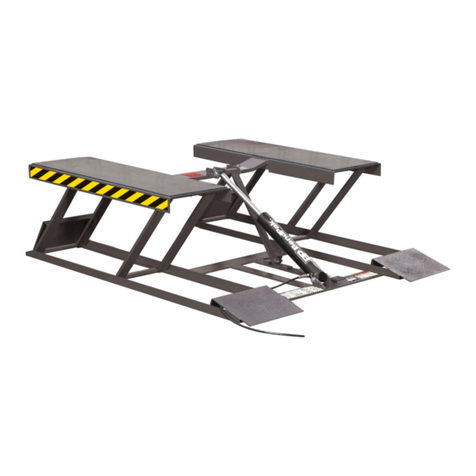
Bend-Pak
Bend-Pak LR-60 User manual
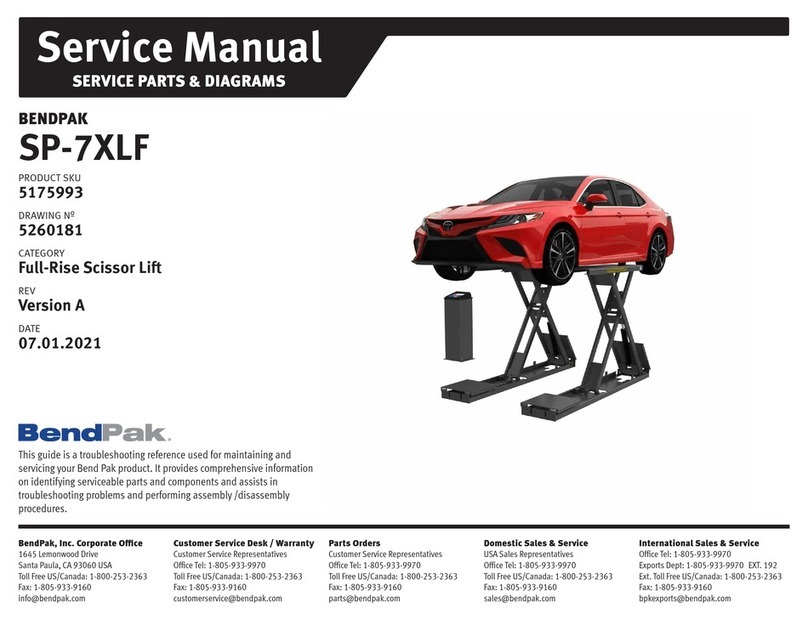
Bend-Pak
Bend-Pak SP-7XLF User manual

Bend-Pak
Bend-Pak LR-10000 User manual
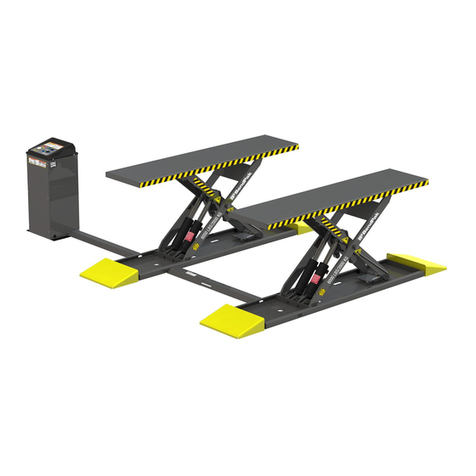
Bend-Pak
Bend-Pak MDS-6 Series User manual
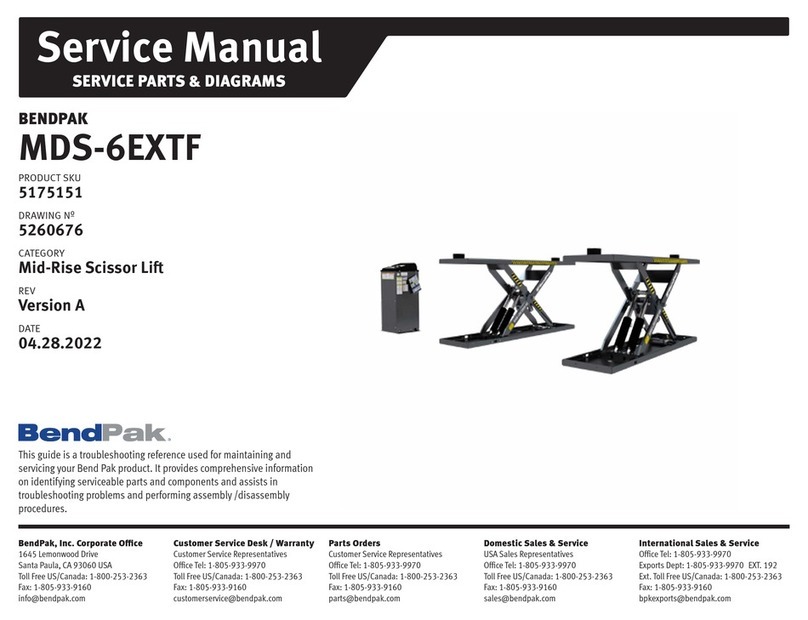
Bend-Pak
Bend-Pak MDS-6EXTF User manual
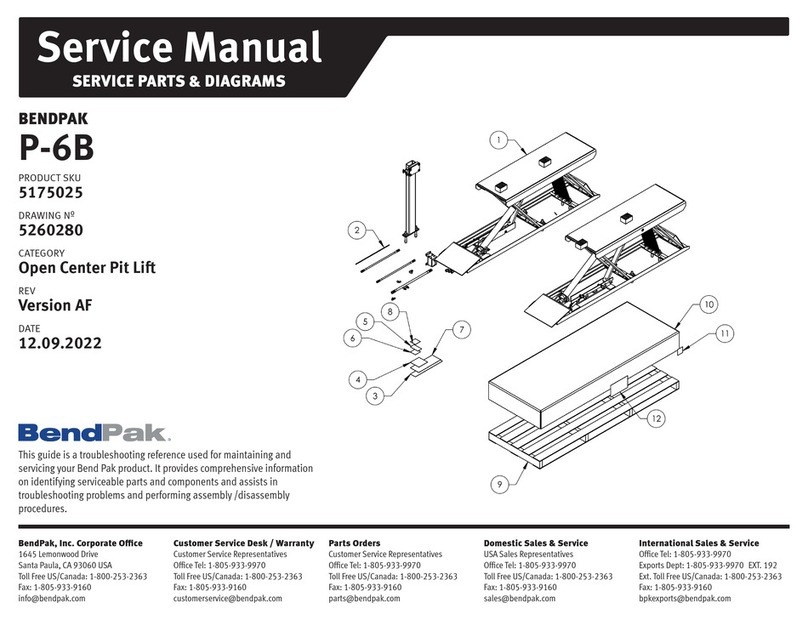
Bend-Pak
Bend-Pak P-6B User manual
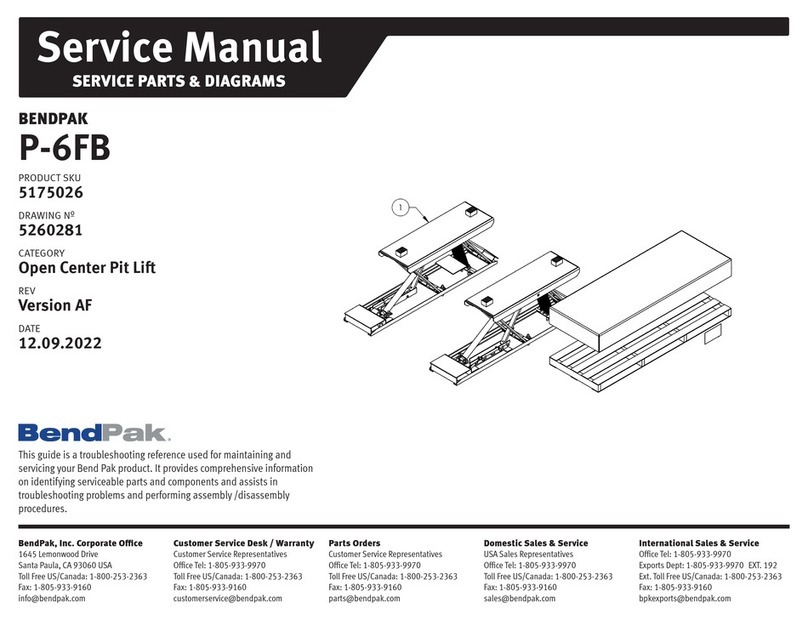
Bend-Pak
Bend-Pak P-6FB User manual
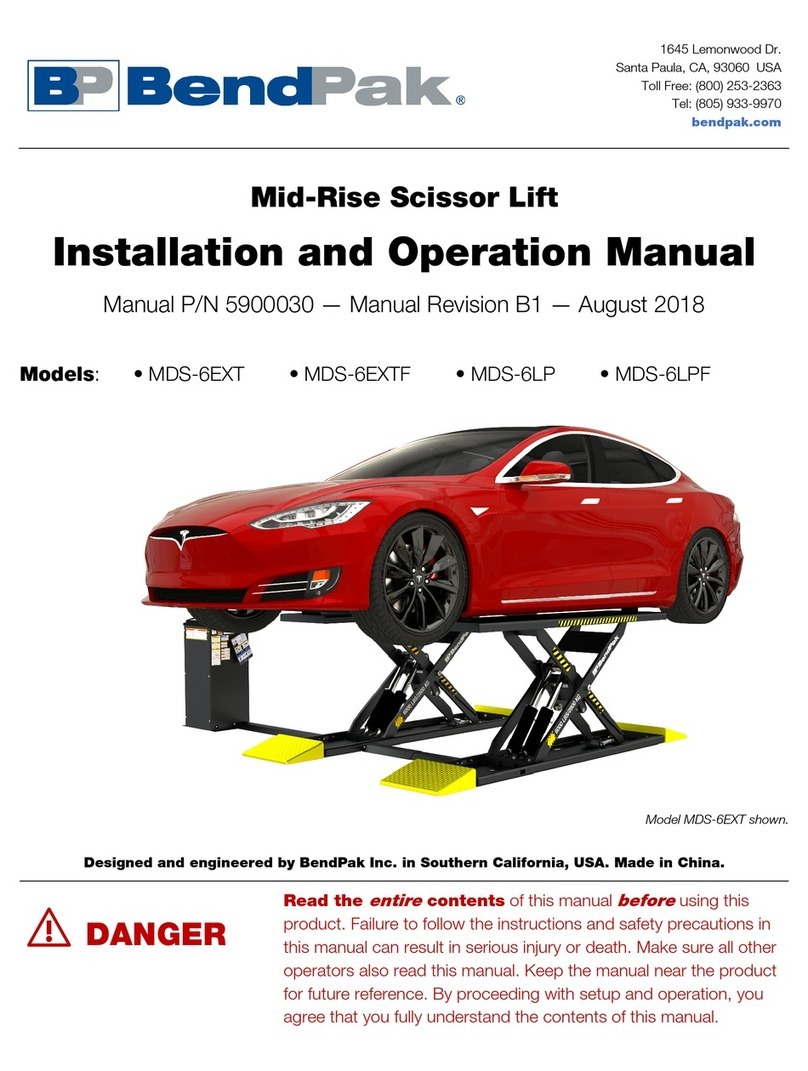
Bend-Pak
Bend-Pak MDS-6EXT User manual

Bend-Pak
Bend-Pak MDS-6LP User manual
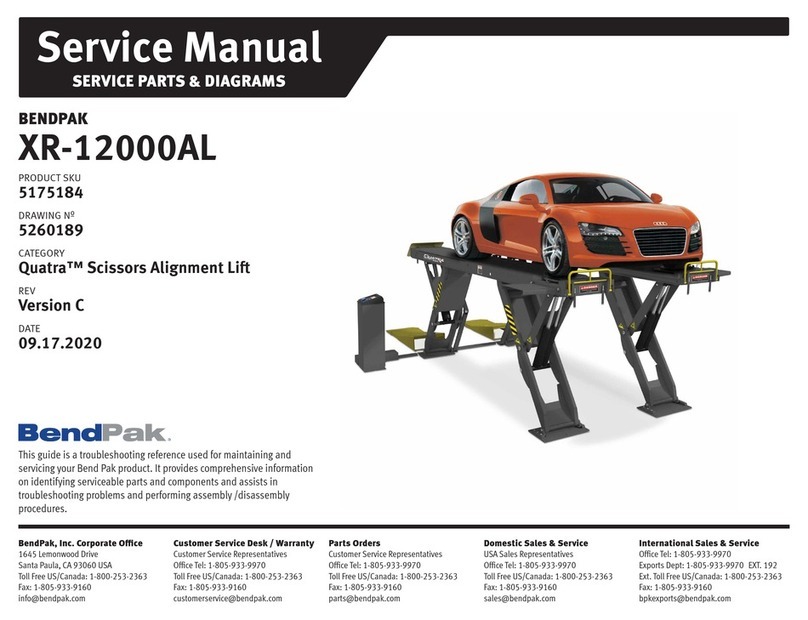
Bend-Pak
Bend-Pak Quatra XR-12000AL User manual

